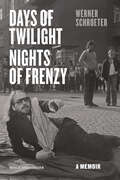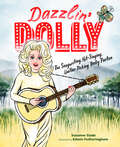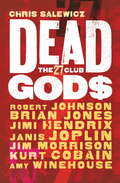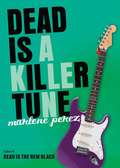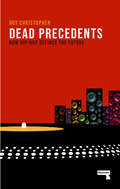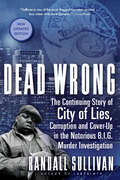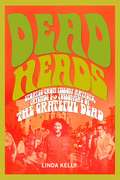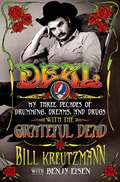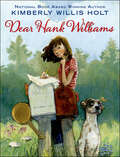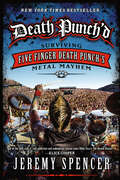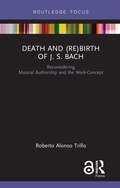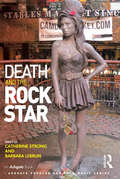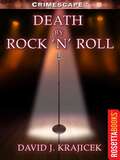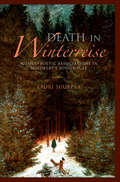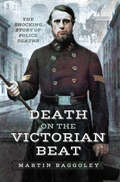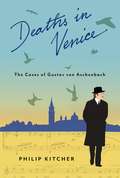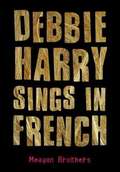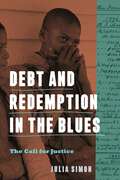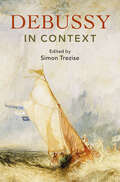- Table View
- List View
Days of Twilight, Nights of Frenzy: A Memoir
by Anthea Bell Claudia Lenssen Werner SchroeterWerner Schroeter was a leading figure of New German Cinema. In more than forty films made between 1967 and 2008, including features, documentaries, and shorts, he ignored conventional narrative, creating instead dense, evocative collages of image and sound. For years, his work was eclipsed by contemporaries such as Wim Wenders, Rainer Werner Fassbinder, Werner Herzog, and Alexander Kluge. Yet his work has become known to a wider audience through several recent retrospectives, including at the Museum of Modern Art, New York. Written in the last years of his life, Days of Twilight, Nights of Frenzy sees Schroeter looking back at his life with the help of film critic and friend Claudia Lenssen. Born in 1945, Schroeter grew up near Heidelberg and spent just a few weeks in film school before leaving to create his earliest works. Over the years, he would work with acclaimed artists, including Marianne Hopps, Isabelle Huppert, Candy Darling, and Christine Kaufmann. In the 1970s, Schroeter also embarked on prolific parallel careers in theater and opera, where he worked in close collaboration with the legendary diva Maria Callas. His childhood; his travels in Italy, France, and Latin America; his coming out and subsequent life as an gay man in Europe; and his run-ins with Hollywood are but a few of the subjects Schroeter recalls with insights and characteristic understated humor. A sharp, lively, even funny memoir, Days of Twilight, Nights of Frenzy captures Schroeter’s extravagant life vividly over a vast prolific career, including many stories that might have been lost were it not for this book. It is sure to fascinate cinephiles and anyone interested in the culture around film and the arts.
Dazzlin' Dolly: The Songwriting, Hit-Singing, Guitar-Picking Dolly Parton
by Suzanne SladeEureka! Nonfiction Silver Honor Award (California Reading Association)This inspirational and dazzlin&’ story of Dolly Parton—noted singer, songwriter, and humanitarian—follows her rise to fame, from her beginnings in East Tennessee to performing to thousands at the Grand Ole Opry in Nashville.Dolly is a little girl with a BIG voice. Music fills Dolly&’s heart so plumb full she has to let it out! She&’ll even sing to her cornhusk dolls or a pen full of pigs. She makes her own drum from a pot and her own guitar from a broken mandolin. But what Dolly dreams of is performing for a real audience—people who would hear her sing, and applaud! And when she gets her big break at age ten, the soul-singin&’ and big-dreamin&’ Dolly discovers she&’s scared to sing on stage in front of all those people. Will she summon up all of her courage and make it to the stage of the Grand Ole Opry in Nashville? Young readers will learn about Dolly&’s early history, her endless creativity, and her plucky perseverance in this entertaining picture book that&’s perfect for fans of all ages.
De padre a hija: Cartas de Alberto Ginastera a su hija Georgina
by Cecilia ScalisiUna biografía del gran compositor argentino Alberto Ginastera a partirde la correspondencia inédita que envió a su hija, Georgina, desdeGinebra, Suiza, en los últimos diez años de su vida. En el año 2006 Georgina Ginastera encontró una vieja caja, oculta eignorada durante treinta años, repleta de sobres, fotos, tarjetas decumpleaños, telegramas y estampillas. Eran las cartas de su padre, unacorrespondencia recibida durante poco más de una década (entre 1971 y1982) y preservada a la espera de una nueva oportunidad de ser leída.A partir de esas cartas, y de largas entrevistas con Georgina, CeciliaScalisi emprendió la tarea de reconstruir, con talento de novelista yprecisión de biógrafa, no solo las profundidades de ese vínculo únicoentre un padre y una hija, sino, a la vez, el retrato singular de unafigura ineludible, un gran músico venerado y vigente tanto en laArgentina como en el mundo: Alberto Ginastera.«De padre a hija» es un libro íntimo, poético, lleno de nostalgia y debelleza, en el cual el perfil del gran compositor argentino emerge desdeuna mirada inédita y peculiar: la mirada a veces caprichosa pero siempreinclaudicable que solo una hija puede dedicar a su padre.
Dead Gods: The 27 Club
by Chris SalewiczRobert Johnson. Brian Jones. Jimi Hendrix. Janis Joplin. Jim Morrison. Kurt Cobain. Amy Winehouse. They were inspirational, controversial, talismanic and innovative. They lead lives full of myth, scandal, sex, drugs and some of the most glorious music that has ever heard. Though each of their lives were cut tragically short at the age of 27, they would all leave the world having changed it irrevocably. Chris Salewicz tells, in intimate detail, the stories behind these compelling figures. From Robert Johnson and his legendary deal with the devil, to Jimi Hendrix appearing like a psychedelic comet on the London scene, through to Amy Winehouse's blazing talent and her savage appetite for self-destruction.
Dead Gods: The 27 Club
by Chris SalewiczRobert Johnson. Brian Jones. Jimi Hendrix. Janis Joplin. Jim Morrison. Kurt Cobain. Amy Winehouse. They were inspirational, controversial, talismanic and innovative. They lead lives full of myth, scandal, sex, drugs and some of the most glorious music that has ever heard. Though each of their lives were cut tragically short at the age of 27, they would all leave the world having changed it irrevocably. Chris Salewicz tells, in intimate detail, the stories behind these compelling figures. From Robert Johnson and his legendary deal with the devil, to Jimi Hendrix appearing like a psychedelic comet on the London scene, through to Amy Winehouse's blazing talent and her savage appetite for self-destruction.
Dead Is a Killer Tune
by Marlene PerezHigh school freshman Jessica Walsh is a Virago--a woman warrior who must protect her hometown from danger. And in Nightshade, California, trouble is always lurking. At the town's Battle of the Bands, Jess's boyfriend, Dominic, and his band, Side Effects May Vary, are up against Hamlin, a band so popular, their fans follow them everywhere. Soon, the competing musicians are doing risky, illegal, and even fatal things--and claiming that they heard strange music that compelled them to do it. Can Jess and her friends track down the tuneful tyrant before it's too late?
Dead Precedents: How Hip-Hop Defines the Future
by Roy ChristopherThe story of how hip-hop created, and came to dominate, the twenty-first century.In Dead Precedents, Roy Christopher traces the story of how hip-hop invented the twenty-first century. Emerging alongside cyberpunk in the 1980s, the hallmarks of hip-hop - allusion, self-reference, the use of new technologies, sampling, the cutting and splicing of language and sound - would come to define the culture of the new millennium.Taking in the groundbreaking work of DJs and MCs, alongside writers like Dick and Gibson, as well as graffiti and DIY culture, Dead Precedents is a counter-culture history of the twentieth century, showcasing hip-hop's role in the creation of the world we now live in.
Dead Wrong: The Continuing Story of City of Lies, Corruption and Cover-Up in the Notorious B.I.G. Murder Investigation
by Randall SullivanThe author of LAbyrinth exposes the cover-up surrounding Biggie Smalls’ murder with exclusive material from the FBI and his estate’s wrongful death suit.In his 2002 book LAbyrinth, acclaimed music journalist Randall Sullivan revealed the story of “gangsta cops” tied to Marion “Suge” Knight’s rap label, Death Row Records—and allegedly to the murders of Tupac Shakur and the Notorious B.I.G. Now in Dead Wrong, Sullivan chronicles more than a decade in the B.I.G. investigations, and uncovers the conspiracy of silence blocking the wrongful death suit against the City.In 2001, an eyewitness identified the man who shot Biggie as Amir Muhammad, a former college roommate of LAPD officer, Death Row associate, and convicted bank robber David Mack. Yet LAPD Detective Russell Poole found his investigation repeatedly directed away from Mack and Muhammad. Biggie’s estate then sued the city to find out why. But instead, investigators encountered a disturbing pattern of selective investigation, hidden evidence, and possible witness tampering.Exclusive interviews with the FBI’s lead investigator of the Biggie murder demonstrate a conspiracy that went to the top, and which implicates some of the most powerful men in law enforcement nationally. Dead Wrong is a gripping investigation into murder, police corruption, and the corridors of power in Los Angeles.
Dead to the Core: An Almanack of the Grateful Dead
by Eric WybengaIt is part reference, part critical companion to the best the Dead have to offer, a work liberally stocked with trivia, lore, humor, and arcana. No Head "farmer" wanting to reap the dankest of the Dead kind will want to be without this essential resource. Includes... Show-a-day seasonal calendars; Detailed show reviews from key years; Musical and lyrical analyses of the Dead's core tunes; Annotated lists of hot versions of key tunes; Capsule reviews of shows from throughout the Dead's career; Personal anecdotes and observations from Deadheads; A guide to the best Dead-related sites on the Internet; In-depth essays on the Dead's prime eras... And much, much more, including the Dead-Dylan connection, the Dead and Garcia's place in the musical universe, the Deadhead pantheon, and tour lore.
Deadheads: Stories from Fellow Artists, Friends & Followers of the Grateful Dead
by Linda Kelly"One of the best books on the Grateful Dead. " --Rolling Stone Just what was it about the Grateful Dead that made them rock and roll’s most beloved band? In Deadheads, those with the real story, who were there and are still listening to the music, explain it all. Grateful Dead lyricist John Perry Barlow talks about his lifelong friendship with Dead guitarist Bob Weir. Cajun chef Rick Begneaud shares his memories of feeding the Dead. John Popper of Blues Traveler recalls playing with the Dead at Bill Graham’s memorial tribute, while publicist Dennis McNally shares some wild adventures of working with the band for more than thirty years. Author Linda Kelly recalls being dragged to her very first Dead show, hanging with Jerry in New York City, and more. First-show revelations, backstage adventures, parking lot hoopla, how-to-live-life philosophies, strange tangential experiences stemming from being in that certain place at that certain time--these intriguing anecdotes evoke wonderful images, lots of smiles, and a close look into a fascinating phenomenon in the history of music. This twentieth-anniversary edition of Deadheads celebrates fifty years of music and includes the best stories from the original 1995 edition, two new chapters, as well as new interviews with various friends, artists, and followers of the Grateful Dead.
Deal: My Three Decades of Drumming Dreams and Drugs with the Grateful Dead
by Bill Kreutzmann Benjy EisenThe Grateful Dead are perhaps the most legendary American rock band of all time. For thirty years, beginning in the hippie scene of San Francisco in 1965, they were a musical institution, the original jam band that broke new ground in so many ways. From the music to their live concert sound systems and fan recordings, they were forward-thinking champions of artistic control and outlaw artists who marched to the beat of their own drums.<P><P> Bill Kreutzmann, one of their founding members and drummer for every one of their over 2,300 concerts has written an unflinching and wild account of playing in the greatest improvisational band of all time. Everything a rock music fan would expect is here, but what sets this apart is Bill's incredible life of adventure that was at the heart of the Grateful Dead experience. This was a band that knew no limits and Bill lived life to the fullest, pushing the boundaries of drugs, drums and high times, through devastating tragedy and remarkable triumph.<P> But at this book's beating heart is the music--theirs and others. Some of the greatest musicians and concerts were a part of the Grateful Dead's career, from sharing the stage with Janis Joplin, Bob Dylan, and The Who, to playing in the Acid Tests, The Monterey Pop Festival, Woodstock and Altamont. Bill's life is a chronicle of American music and pop culture history and his epic personal journey is one of sonic discovery and thrilling experiences.
Dear Evan Hansen
by Steven LevensonA letter that was never meant to be seen, a lie that was never meant to be told, a life he never dreamed could be his. Evan Hansen is about to get the one thing he’s always wanted: a chance to belong. Deeply personal and profoundly universal, Dear Evan Hansen is a groundbreaking American musical about truth, fiction, and the price we’re willing to pay for the possibility to connect.
Dear Hank Williams (Penworthy Picks Middle School Ser.)
by Kimberly Willis HoltIt's 1948 in Rippling Creek, Louisiana, and Tate P. Ellerbee's new teacher has just given her class an assignment—learning the art of letter-writing. Luckily, Tate has the perfect pen pal in mind: Hank Williams, a country music singer whose star has just begun to rise. Tate and her great-aunt and -uncle listen to him on the radio every Saturday night, and Tate just knows that she and Hank are kindred spirits.Told entirely through Tate's hopeful letters, this beautifully drawn novel from National Book Award–winning author Kimberly Willis Holt gradually unfolds a story of family love, overcoming tragedy, and an insightful girl learning to find her voice.This title has Common Core connections.
Death Punch'd: Surviving Five Finger Death Punch's Metal Mayhem
by Jeremy SpencerA fascinating inside account of one of the most successful heavy metal bands of the past decade and a revealing personal journey through the wild highs and terrifying lows of rock 'n' roll from the cofounder of Five Finger Death Punch, Jeremy Spencer"Everything, including success, comes with a price."Hailed by the New York Times as "one of the most unexpectedly consistently popular bands," Five Finger Death Punch has become the heavyweight champ of the metal scene. In this soulful, inspiring, and entertaining memoir, Jeremy Spencer, the band's cofounder and drummer, takes us behind the scenes, on tour, and into the studio to tell the band's raucous story and his own.Death Punch'd is a detailed in-depth account of the group's origins and influences. With fierce honesty and self-deprecating playfulness, Jeremy details cutting the band's first demo and hitting the road to tour the world, providing snapshots of a life fueled by sex, booze, drugs, and a thrashing metal sound. He also reveals the fighting and tensions among highly opinionated musicians that grew increasingly out of control—battles that created both intense drama and the music fans love.In addition to pulling back the curtain on the band, Death Punch'd tells Jeremy's personal hard-charging, laugh-out-loud tale of how he left small-town Indiana with $150 in his pocket and rose to rock royalty—and how he nearly destroyed it all for a good time. Jeremy takes us back to his childhood in the eighties, introduces us to his down-to-earth family, and recalls adolescent exploits and a journey to addiction that landed him in rehab at sixteen—dangerous behavior that became bigger, bolder, and badder until Jeremy bottomed out before it was too late.Told in his unique, darkly humorous voice, filled with Jeremy's twisted take on how his rock 'n' roll dream turned nightmare, and including dozens of photos, Death Punch'd is a lively, no-holds-barred ride as well as a sincere and inspiring cautionary tale to help anyone who is struggling to battle demons and addictions of their own.
Death and (Re) Birth of J.S. Bach: Reconsidering Musical Authorship and the Work-Concept
by Roberto Alonso TrilloWhile the study and redefinition of the notion of authorship and its relationship to the idea of the literary work have played a central role in recent research on literature, semiotics, and related disciplines, its impact on contemporary musicology is still limited. Why? What implications would a reconsideration of the author- and work-concepts have on our understanding of the creative musical processes? Why would such a re-examination of these regulative concepts be necessary? Could it emerge from a post-structuralist revision of the notion of musical textuality? In this book, Trillo takes the …Bach… project, a collection of new music based on Johann Sebastian Bach’s Partita No.1 for solo violin, BWV 1002, as a point of departure to sketch some critical answers to these fundamental questions, raise new ones, and explore their musicological implications.
Death and the Rock Star (Ashgate Popular and Folk Music Series)
by Catherine Strong Barbara LebrunThe untimely deaths of Amy Winehouse (2011) and Whitney Houston (2012), and the ’resurrection’ of Tupac Shakur for a performance at the Coachella music festival in April 2012, have focused the media spotlight on the relationship between popular music, fame and death. If the phrase ’sex, drugs and rock’n’roll’ ever qualified a lifestyle, it has left many casualties in its wake, and with the ranks of dead musicians growing over time, so the types of death involved and the reactions to them have diversified. Conversely, as many artists who fronted the rock’n’roll revolution of the 1950s and 1960s continue to age, the idea of dying young and leaving a beautiful corpse (which gave rise, for instance, to the myth of the ’27 Club’) no longer carries the same resonance that it once might have done. This edited collection explores the reception of dead rock stars, ’rock’ being taken in the widest sense as the artists discussed belong to the genres of rock’n’roll (Elvis Presley), disco (Donna Summer), pop and pop-rock (Michael Jackson, Whitney Houston, Amy Winehouse), punk and post-punk (GG Allin, Ian Curtis), rap (Tupac Shakur), folk (the Dutchman André Hazes) and ’world’ music (Fela Kuti). When music artists die, their fellow musicians, producers, fans and the media react differently, and this book brings together their intertwining modalities of reception. The commercial impact of death on record sales, copyrights, and print media is considered, and the different justifications by living artists for being involved with the dead, through covers, sampling and tributes. The cultural representation of dead singers is investigated through obituaries, biographies and biopics, observing that posthumous fame provides coping mechanisms for fans, and consumers of popular culture more generally, to deal with the knowledge of their own mortality. Examining the contrasting ways in which male and female dead singers are portrayed in the media, the book
Death by Rock ‘n’ Roll
by David J. Krajicek Marilyn J. Bardsley(A 90-page True Crime Short with photographs) On April 1, 1984, Marvin Gaye--one of the world's most beloved singers--was gunned down by his own father. A generation later, fans still puzzle over how it could be that a man who crooned about peace, love, and understanding could possibly meet with such a violent end--and from his own flesh and blood. Yet the history of popular music is written in blood. Using the slaying of Marvin Gaye as an abject example of the rock and roll lifestyle, David J. Krajicek's Death by Rock and Roll pulls together the threads of the violent ends of music stars like John Lennon, Sam Cooke, Tupac Shakur, soul saxophone legend King Curtis, and many others. Between overdoses and suicides of what are often fragile stars, rock and roll seems to qualify as one of Americas most dangerous professions. Here, experts weigh in on whether there are patterns to the violence of rock and roll and whether there have been warning signs in some cases that may have saved some lives. A fascinating read.
Death in Winterreise
by Lauri SuurpääLauri Suurpää brings together two rigorous methodologies, Greimassian semiotics and Schenkerian analysis, to provide a unique perspective on the expressive power of Franz Schubert's song cycle. Focusing on the final songs, Suurpää deftly combines textual and tonal analysis to reveal death as a symbolic presence if not actual character in the musical narrative. Suurpää demonstrates the incongruities between semantic content and musical representation as it surfaces throughout the final songs. This close reading of the winter songs, coupled with creative applications of theory and a thorough history of the poetic and musical genesis of this work, brings new insights to the study of text-music relationships and the song cycle.
Death on the Victorian Beat: The Shocking Story of Police Deaths
by Martin BaggoleyDeath on the Victorian Beat is the first book dedicated solely to the murders of police officers in the Victorian era, recalling numerous cases from across the United Kingdom. Martin Baggoley highlights the resistance faced everyday by officers of all ranks, in both the great cities and in the supposedly peaceful countryside, during this important and sometimes turbulent period in our history.Many cases are unveiled by the author, including those of: Sergeant Charles Brett, murdered on the streets of Manchester by Fenians attempting to release two of their leaders from a police van; Detective Inspector Charles Thain, fatally wounded at sea by a prisoner he was escorting back from Germany; Constable William Jump lost his life during a bitter industrial dispute involving brickmakers in Ashton-under-Lyne; and Inspector Joseph Drewitt and Constable Thomas Shorter murdered in a confrontation with poachers in Hungerford, to name but a few.This book is bursting with accounts of danger and great courage urging to be read, as the author allows the lives of these gallant officers to run through the pages.
Deaths in Venice
by Philip KitcherPublished in 1913, Thomas Mann's Death in Venice is one of the most widely read novellas in any language. In the 1970s, Benjamin Britten adapted it into an opera, and Lucchino Visconti turned it into a successful film. Reading these works from a philosophical perspective, Philip Kitcher connects the predicament of the novella's central character to Western thought's most compelling questions.In Mann's story, the author Gustav von Aschenbach becomes captivated by an adolescent boy, first seen on the lido in Venice, the eventual site of Aschenbach's own death. Mann works through central concerns about how to live, explored with equal intensity by his German predecessors, Schopenhauer and Nietzsche. Kitcher considers how Mann's, Britten's, and Visconti's treatments illuminate the tension between social and ethical values and an artist's sensitivity to beauty. Each work asks whether a life devoted to self-sacrifice in the pursuit of lasting achievements can be sustained, and whether the breakdown of discipline undercuts its worth. Haunted by the prospect of his death, Aschenbach also helps reflect on whether it is possible to achieve anything in full awareness of our finitude and in knowing our successes are always incomplete.
Deaths in Venice: The Cases of Gustav von Aschenbach (Leonard Hastings Schoff Lectures)
by Philip KitcherPublished in 1913, Thomas Mann's Death in Venice is one of the most widely read novellas in any language. In the 1970s, Benjamin Britten adapted it into an opera, and Luchino Visconti turned it into a successful film. Reading these works from a philosophical perspective, Philip Kitcher connects the predicament of the novella's central character to Western thought's most compelling questions. In Mann's story, the author Gustav von Aschenbach becomes captivated by an adolescent boy, first seen on the lido in Venice, the eventual site of Aschenbach's own death. Mann works through central concerns about how to live, explored with equal intensity by his German predecessors, Schopenhauer and Nietzsche. Kitcher considers how Mann's, Britten's, and Visconti's treatments illuminate the tension between social and ethical values and an artist's sensitivity to beauty. Each work asks whether a life devoted to self-sacrifice in the pursuit of lasting achievements can be sustained and whether the breakdown of discipline undercuts its worth. Haunted by the prospect of his death, Aschenbach also helps us reflect on whether it is possible to achieve anything in full awareness of our finitude and in knowing our successes are always incomplete.
Debbie Harry Sings in French
by Meagan BrothersWhen Johnny gets out of court-mandated rehab and his mother sends him to live with his uncle in North Carolina, he meets Maria, who seems to understand his fascination with the new wave band Blondie, and he learns about his deceased father's youthful forays into glam rock, all of which gives him perspective on himself, his past, and his current life.
Debby Ryan: Her Sweet Life
by Riley BrooksHow did Debby Ryan go from being a shy child to a star? Where did she live for a few years while her father was in the Army? What language is she fluent in? Who is her best friend? Find out these answers and so much more!
Debt and Redemption in the Blues: The Call for Justice (American Music History)
by Julia SimonThis volume explores concepts of freedom and bondage in the blues and argues that this genre of music explicitly calls for a reckoning while expressing faith in a secular justice to come. Placing blues music within its historical context of the post-Reconstruction South, Jim Crow America, and the civil rights era, Julia Simon finds a deep symbolism in the lyrical representations of romantic and sexual betrayal. The blues calls out and indicts the tangled web of deceit and entrapment constraining the physical, socioeconomic, and political movement of African Americans. Surveying blues music from the 1920s to the early twenty-first century, Simon’s analyses focus on economic relations, such as sharecropping, house contract sales, debt peonage, criminal surety, and convict lease. She demonstrates how the music reflects this exploitative economic history and how it is shaped by commodification under racialized capitalism. As Simon assesses the lyrics, technique, and styles of a wide range of blues musicians, including Bessie Smith, Blind Lemon Jefferson, Big Bill Broonzy, Muddy Waters, B. B. King, Albert Collins, and Kirk Fletcher, she argues forcefully that the call for racial justice is at the heart of the blues.A highly sophisticated interpretation of the blues tradition steeped in musicology, social history, and critical-cultural hermeneutics, Debt and Redemption not only clarifies blues as an aesthetic tradition but, more importantly, proves that it advances a theory of social and economic development and change.
Debussy in Context (Composers in Context)
by Simon TreziseExploring the many dimensions of Debussy's historical significance, this volume provides new perspectives on the life and work of a much-loved composer and considers how social and political contexts shape the way we approach and perform his works today. In short, focused chapters building on recent research, contributors chart the influences, relationships and performances that shaped Debussy's creativity, and the ways he negotiated the complex social and professional networks of music, literature, art, and performance (on and off the stage) in Belle Époque Paris. It probes Debussy's relationship with some of the most influential '-isms' of his time, including his fascination with early music and with the 'exotic', and assesses his status as a pioneer of musical modernism and his continuing popularity with performers and listeners alike.
